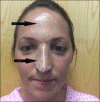The Preventative Effect of Hydrocolloid Dressings on Nasal Bridge Pressure Ulceration in Acute Non-Invasive Ventilation
- PMID: 30675073
- PMCID: PMC6342034
The Preventative Effect of Hydrocolloid Dressings on Nasal Bridge Pressure Ulceration in Acute Non-Invasive Ventilation
Abstract
Background: Non-invasive ventilation (NIV) is a valuable treatment in the management of acute hypercapnic respiratory failure. NIV is not without risks. One such adverse effect is the development of pressure ulcers over the nasal bridge which have an incidence of up to 20% of patients requiring NIV in this setting. The role of medical devices in the development of hospital acquired pressure ulcers has been increasingly recognised with 10-35% of all hospital acquired ulcers attributed to medical devices. Guidelines on acute NIV use suggest good skin care strategies. However, data on the magnitude of the problem of nasal bridge pressure ulceration and the effect of proactive preventative steps remains scant.
Method: A quality improvement project was designed to reduce the incidence of nasal bridge pressure ulcers during acute NIV. Hydrocolloid dressings were placed over the nasal bridge in all patients requiring NIV between 30th October 2015 and the 29th October 2016. Tissue viability was assessed daily with new pressure ulceration defined as grade 2 or above. Rates of nasal bridge pressure ulcers were compared to all patients requiring NIV in the 12-month period prior to intervention.
Results: In Group 1, there were 161 admissions and 9 grade 2 pressure ulcers from 666 NIV bed-days. In Group 2 there were 134 admissions and 0 pressure ulcers from 718 NIV bed-days. There was a statistically significant reduction in grade 2 pressure ulceration rates (p= 0.0013) in Group 2 compared to Group 1.
Conclusion: Application of an early prophylactic pressure-relieving hydrocolloid nasal dressing reduces the risk of developing grade 2 pressure ulcers in patients in patients requiring acute NIV.
Keywords: Hydrocolloid; non-invasive ventilation; patient safety; pressure ulcer; wound care.
Conflict of interest statement
Provenance: externally peer-reviewed.
Figures


Comment in
-
PREVENTION OF PRESSURE ULCERS IN NASAL BRIDGE DURING NON-INVASIVE MECHANICAL VENTILATION. DISCUSSION OF RESULTS.Ulster Med J. 2019 Sep;88(3):183. Epub 2019 Oct 11. Ulster Med J. 2019. PMID: 31619858 Free PMC article. No abstract available.
References
-
- Juniper M, Ellis G, Smith NC, Protopapa KL, Mason M. NCEPOD reports 2017. London:: National Confidential Enquiry into Patient Outcome and Death; 2017.; 2017. Inspiring change: a review of the quality of care provided to patients receiving acute non-invasive ventilation. [Internet] Available from: http://www.ncepod.org.uk/2017niv.html. [Accessed September 2018]
-
- Davies M. London:: 2013. British Thoracic Society. NIV Adult 2013 (national audit period 1 February – 31 March 2013) [Internet] Available from: https://www.brit-thoracic.org.uk/document-library/audit-and-quality-impr... [Accessed September 2018]
-
- Roberts CM, Stone RA, Buckingham RJ, Pursey N, Lowe D, National Chronic Obstructive Pulmonary Disease Resources and Outcomes Project implementation group. Acidosis, non-invasive ventilation and mortality in hospitalised COPD exacerbations. Thorax. 2011;66((1)):43–8. - PubMed
-
- Plant PK, Owen JL, Elliott MW. Early use of non-invasive ventilation for acute exacerbations of chronic obstructive pulmonary disease on general respiratory wards: a multicenter randomised controlled trial. Lancet. 2000;355((9219)):1931–5. - PubMed
-
- Yamaguti WP, Moderno EV, Yamashita SY, Gomes TG, Maida AL, Kondo CS, et al. Treatment-related risk factors for development of skin breakdown in subjects with acute respiratory failure undergoing non-invasive ventilation or CPAP. Respir Care. 2014;59((10)):1530–6. - PubMed
MeSH terms
LinkOut - more resources
Full Text Sources
Medical
